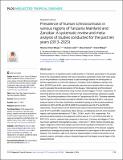| dc.description.abstract | Schistosomiasis is a significant public health problem in Tanzania, particularly for the people living in the marginalized settings. We have conducted a systematic review with meta-analysis on the prevalence of schistosomiasis to add knowledge towards the development of effective approaches to control the disease in Tanzania. Online databases namely, Pub Med, SCOPUS and AJOL, were systematically searched and a random effect model was used to calculate the pooled prevalence of the disease. Heterogeneity and the between studies variances were determined using Cochran (Q) and Higgins (I2) tests, respectively. A total of 55 articles met the inclusion criterion for this review and all have satisfactory quality scores. The pooled prevalence of the disease in Tanzania was 26.40%. Tanzania mainland had the highest schistosomiasis prevalence (28.89%) than Zanzibar (8.95%). Sub-group analyses based on the year of publication revealed the going up of the pooled prevalence, whereby for (2013–2018) and (2018–2023) the prevalence was 23.41% and 30.06%, respectively. The prevalence of the Schistosoma mansoni and Schistosoma hematobium were 37.91% and 8.86% respectively. Mara, Simuyu, and Mwanza were the most prevalent regions, with a pooled prevalence of 77.39%, 72.26%, and 51.19%, respectively. The pooled prevalence based on the diagnostic method was 64.11% for PCR and 56.46% for POC-CCA, which is relatively high compared to other tests. Cochrans and Higgins (I2) test has shown significant heterogeneity (p-value = 0.001 and I2 = 99.6). Factors including age, region, diagnostic method and sample size have shown significant contribution to the displayed heterogeneity. The pronounced and increasing prevalence of the disease suggests potential low coverage and possibly lack of involvement of some regions in the control of the disease. This, therefore, calls for an intensive implementation of control interventions in all endemic regions, preferably using an integrated approach that targets several stages of the disease lifecycle. | en_US |

